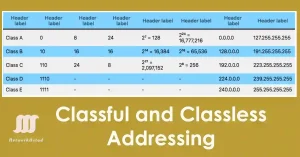Classful vs Classless Addressing Definitive Guide 2025 – From Confusion to Confidence in IP Addressing
Classful addressing emerged in the early Internet (1980s) with fixed Class A, B, and C ranges, leading to IP address exhaustion. The introduction of CIDR in 1993 marked the shift to classless addressing, allowing flexible prefixes (e.g., /20) and supporting the IPv4-to-IPv6 transition Classful and Classless addressing are terms describing IP address structure, with classless

